65 years ago, on May 7, 1954, in Dien Bien Phu, in the northwest of Vietnam, the French expeditionary force suffered a terrible defeat. In 2003, for the first time, French and Vietnamese historians met in Paris at a symposium. Science and the Future attended this historic meeting:we invite you to read this article, originally published in May 2004.
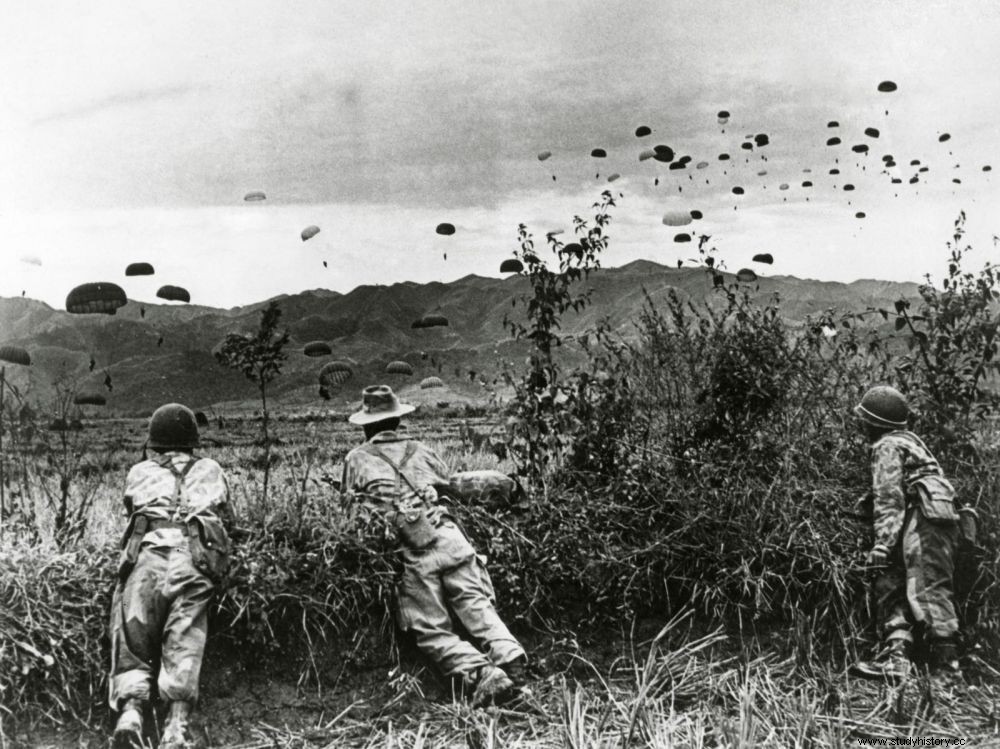
In the spring of 1954, soldiers of the French Far East Expeditionary Force, in the plain of Dien Bien Phu.
On May 7, 1954, in Dien Bien Phu, in the northwest of Vietnam, the French expeditionary force suffered a terrible defeat after 55 days of combat. Fifty years later, in 2003, French and Vietnamese historians met for the first time in Paris, during a symposium organized by the University of Paris-1 and the Center for Defense History Studies ( CEHD), under the direction of Pierre Journoud, author of the recent book Dien Bien Phu, the end of a world , published by Éditions Vendémiaire (April 2019). Vietnamese researchers then revealed the incredible logistics implemented to win the battle.
There are names that hurt the memory of a nation. Diên Biên Phu is one of them. "Should we talk about memory, or a memory lapse ?”, asks historian Benjamin Stora. Fifty years later, what remains of the terrible French defeat? Of this tragedy played out between March 13 and May 7, 1954 in the rice fields of northwestern Viet Nam, against the backdrop of the Cold War and decolonization.
With 3,500 dead on the French side, and more than 10,000 prisoners, Diên Biên Phu was first an abyss of suffering. Also humiliating. For a people who were already trying to practice amnesia at the mere statement of the debacle of 1940, the impossible defeat of 1954 sounded the death knell for a colonial empire.
Half a century later, painful memory is gradually giving way to history. The fiftieth anniversary commemorations were the occasion for an exceptional event:for the first time, French and Vietnamese historians were brought together for a symposium organized at the end of 2003 by the University of Paris-i and the Center d Defense History Studies (CEHD). Many interventions have renewed the vision of the battle. This is how Vietnamese historians have publicly evoked the role of Chinese assistance, hitherto concealed, or the incredible logistics implemented to support the Viet Minh fighters.
Eight years of war already
In 1953, the war, which had already lasted eight years, was at an impasse. It began after the Japanese coup in March 1945 in Indochina, and France's objective was initially to reconquer its lost territory:the French Expeditionary Corps in the Far East (CEFEO), mobilized in metropolitan France and in the empire, was deployed in 1946. But in 1949, with the victory of Mao Zedong in Beijing, the conflict evolved:it was now a matter of stemming the communist push. In 1954, the Expeditionary Force reached 184,000 men:metropolitans, Africans and North Africans, legionnaires, Indochinese enlisted on the spot. The former French Indochina was then cut in two. North of 16 th parallel, Ho Chi Minh proclaimed in September 1945 the Democratic Republic of Vietnam (RDV); power there is in the hands of the Viet Minh, even if France controls a few limited areas around Hanoi and around Diên Biên Phu (see map) . In the south, an "associated state" was established under French tutelage, led by the ex-emperor Bao Dai.
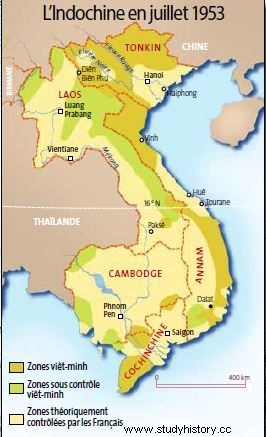
The trap closes on the entrenched camp
Seen from mainland France, this Asian conflict seems very distant to the French and is very expensive for its rulers:in 1946, it represented 17% of the defense budget, in 1950, 45%. At the very time when, barely out of the Second World War, the Western powers were thinking above all of rearming against the new enemy, the USSR. France then counted on financial aid from the United States (which would cover 80% of military expenditure in 1954). On May 8, 1953, General Henri Navarre was appointed Commander-in-Chief of the CEFEO. Its mission:to put in place a "plan" that will allow France to emerge from the conflict in an honorable way.
290 km west of Hanoi, near Laos and the Chinese border, lies the plain of Diên Biên Phu (see map) . To block access to Laos is to try to prevent the communist junction with the other regions of Indochina, Cambodia, Cochinchina, Laos, Annam. But in 1953, the Laos border was already in the hands of the Viet Minh.
In this area of about ten kilometers wide, peaceful poppy farmers have lived for centuries. These mountain ethnic minorities, called Thais of the high regions, will also find themselves mixed up in the turmoil. "In November 1953, when the first soldiers of the Expeditionary Force settled in Diên Biên Phu, it was only a secondary operation, explains historian Hugues Tertrais. A battle among others. The seventh conducted in Indochina since 1946." No one suspected at the time that the adversary had decided otherwise. All of his forces will be thrown into the engagement.
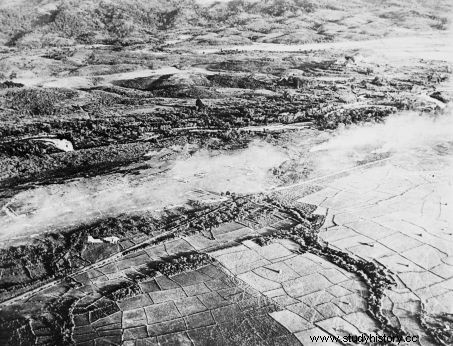
Aerial view of the Dien Bien Phu site in 1954. Four months after the arrival of the soldiers, the plain has turned into an entrenched camp. Over ten kilometers, it is a real trap, mined, bristling with barbed wire. Vital lung of the system, an aerodrome, the only access for supplies. ©AFP
" Diên Biên Phu is an entrenched camp in which the Expeditionary Force has installed a formidable “hedgehog” – a defensive tactic the opponent must come crashing into ", continues Hugues Tertrais. At the heart of this system, an aerodrome, the only access for refueling. "Diên Biên Phu is the only flat place in the region ", recalls the historian.
The configuration of the land will later fuel many controversies. Because if Hugues Tertrais speaks of a "flat place", others evoke a basin in which the French would have trapped themselves. In February 1954, in a famous article entitled "Week-end à Diên Biên Phu", Robert Guillain, journalist at Le Monde, said:"The visitor who falls in there from the top of the sky is assailed at the first moment by a mess of impressions that take his breath away. The impression of being surrounded, caged, hemmed in ; that also of being seen from everywhere, that each movement must be seen by the enemy, who looks down from above... It's a stadium of 20 kilometres. The bottom of the stadium is ours. The bleachers to the enemy." Everything is said.
On the Vietnamese side, only a landslide victory was considered. "From the start, we bet everything on Diên Biên Phu" , explains today Nguyen Van Khanh, from the School of Social Sciences and Humanities in Hanoi. "The concentration of the French Expeditionary Force in northern Tonkin was becoming too dangerous. By the end of September 1953, the political bureau of the Viet Minh had made the decision to attack." The fate of the battle was sealed even before the first cannon shots were exchanged, Chinese advisers and North Vietnamese officials having decided to force the French adversary to disperse his troops. "Make him open his hand to spread his fingers ", according to the colorful formula of General Vô Nguyên Giap, head of the Viet Minh armies and national hero.
Paris sees nothing coming
NATO has barely emerged from the baptismal font. In Paris, governments and incoherent decisions follow one another. The financial burden of the conflict weighs increasingly heavy. We must find a solution. But with whom to negotiate? What concessions to make? Hope for an honorable solution seems to dawn after Stalin's death in March 1953. Alas, blood continues to flow in the peninsula. On March 11, 1954, a restricted war committee was created. It's already too late.
In Geneva, a peace conference tries to settle the problem of Korea* and that of Indochina. China and the Soviet Union openly support the Democratic Republic of Vietnam. The United States is on the side of France and the associated state of Bao Dai. Far from the hushed salons, and without France having seen the magnitude of the drama coming, the plain of Diên Biên Phu is set ablaze.
The opposing forces
The Expeditionary Force. "Between March 13 and May 7, 1954, 15,172 men will coexist in Diên Biên Phu , explains Laure Cournil, researcher at Paris-1. French fighters from the Expeditionary Force from mainland France provide support. There are also a large number of soldiers from the French Union (all the colonies) – from Morocco, Senegal, Algeria – not to mention the mountain dwellers from the Hauts Plateaux, Laos, Thais, Cambodians or Vietnamese from the Bao Dai Government National Army ". Until March 13, 1954, the life of the garrison is that of a hive which organizes its defense. "It is a kind of gigantic and complicated trap, bristling with spikes, bloated with works, , dug, compartmentalised, plowed over square kilometres, and more inhabited than an anthill…underground, in the holes live men…on the surface, nothing has grown, except the proliferation of a bramble of metal:barbed wire ", writes Robert Guillain. Since the end of the Second World War, this army has not had time to restructure. Its men have not stopped fighting. "Everyone has forgotten that well soldiers present in Diên Biên Phu liberated France, made the Italian campaign, and continued with the feeling of continuing in Indochina the fight waged against the totalitarian regimes in Europe " adds Pierre Journoud, historian of the CEHD.
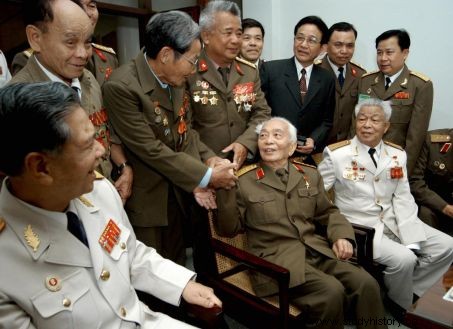
The legendary General Giap, in 2004, at the age of 92, surrounded by Vietnamese veterans. In 1954, he decided to make Dien Bien Phu the final battle. While the French thought they were carrying out only a secondary operation. For 55 days and 55 nights, the French garrison suffered a deluge of fire. ©AFP
General Giap's army. Assisted by Chinese advisers, the Viet Minh army received material support from China and the Soviet Union. "Between 1951 and 1954, the total contribution of foreign aid to the independence army reached 22% per year, said General Vuong Hong Trinh, of the Institute of Military History of Viet Nam. Nam, during the Paris conference. We had 20,000 105 mm shells, of which 3600 had been delivered by China. 7000 others only arrived after the battle. " These numbers, which were a first, could even be made even more explicit, after a question was asked about their origin. "Did these shells come from China or from the Soviet Union? ? Accurate, the response left the audience speechless:"Of the 20,000 shells, 10,000 had been intercepted as booty during parachute drops to the French army. Another 5,000 recovered on battlefields As for Soviet aid and Chinese, it was effective, but it is difficult for us to determine it."
The 55 days of Dien Bien Phu
On March 13, 1954, the first Viet Minh waves fell on the entrenched camp. The deluge of fire will last 55 days and 55 nights without interruption! Until the revelations of the symposium, little information had filtered through on the strategic and tactical aid provided by China. In fact, as early as January 26, 1954, General Giap asked to meet with Chinese advisers to modify his strategy.
Diên Biên Phu quickly turns into a battle of muddy trenches, reminiscent of Verdun and the First World War. Shelters, trenches, hand-to-hand combat. The attacks are incredibly violent. To advance 300 meters, men die by the hundreds. Acts of immense bravery are reported. It will only be known later that the men of the French Expeditionary Force fought one against five. 100,000 combatants surrounded them, supplied, moreover, by 200,000 women and men (read the box above) – figure remained unknown for a long time.
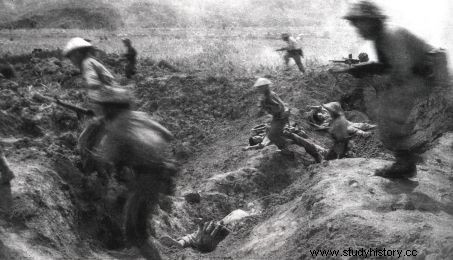
A scene of the battle reconstructed for the purposes of a propaganda film by Soviet filmmaker Roman Karmen. ©AFP
France, absorbed in its internal concerns, belatedly took the measure of the drama before fearing a tropical Sedan. An American intervention plan is even imagined, which will never be implemented. To understand these alliances, Diên Biên Phu must be placed in the context of the Cold War. If the Americans helped France so much in 1953, it was because, bruised by the Korean War (1950-1953)*, they saw in it a nation at the forefront of the "free world", to use the expression of the 'time.
Through lack of foresight, through stubbornness, few people admitted in the 1950s that they were simply faced with a people doing nothing but defending their homeland. In retrospect, the underestimation of the opponent is staggering. In Diên Biên Phu, despite the French aerial bombardments, the supply lines will never be cut.
The great silence of defeat
"Diên Biên Phu was a ruthless battle" , recalled General Trinh, at the conference. The ceasefire came into effect on May 7, 1954 between 5 and 5:30 p.m.. When asked how he had understood "in the midst of this hell that the battle was over " , General de Biré, president of the National Association of Diên Biên Phu fighters, replied:"The day when silence suddenly fell. Like during a parachute jump when, brutally , in the void, the silence becomes total. After 55 days and nights of fury, this sudden rupture signaled to us that something was happening ."
In France, it is the collapse. Stupor. Indignation. Sadness. Public opinion, unprepared for failure, feels as though it has been taken back to the dark times of 1940. The belated – and painful – awareness of what happened in Asia is breaking down the wall of public indifference. The emotion is at its peak. In the plain of Tonkin, however, hell is not over. Less than twenty-four hours after the defeat, the soldiers pass from the state of combatants to that of prisoners.
The ordeal of the prisoners
The Viet Minh took 11,721 prisoners among the garrison, including 4,436 wounded. 3420 men are declared dead or missing. 858 deemed "too" seriously affected are evacuated under the supervision of the Red Cross.
10,863 prisoners will then have to walk for a month and a half and cover 600 kilometers on foot, at night, towards the Chinese border. For food, a handful of rice a day. Malaria, dysentery, lack of care, forced marches... over the miles, many die of exhaustion. Upon arrival in the camps, tuberculosis, scurvy, parasitic diseases, and also madness, continue to wreak havoc among the prisoners. On July 20 and 21, 1954, the peace accords were finally signed in Geneva. Under the terms of these, the prisoners of war must be released, but less than half emerge from the camps, only four months after Diên Biên Phu. "There is debate around these figures, depending on whether or not a group of 3,000 Indochinese prisoners were taken into account, whose exact fate was never known ", points out the historian Pierre Journoud. Interned in special camps? Eliminated?
Back in Europe, the first survivors of the "re-education" camps are compared to the deportees of the Second World War. "The search for those responsible becomes obsessive , recalls the historian Anne Logeay. On the left as on the right, opinion remains fixated on defeat, crystallized on a trauma that it manages neither to analyze nor to overcome. "During the Vietnam War, the Americans will be haunted by this same obsession:especially not a new Diên Biên Phu! Whether it is the offensive of Khe San, in 1968, or the battle of Kontum, in 1972, the specter of French defeat will never cease to hover.
In a moving speech, historian Benjamin Stora attempted to explain the French silence after Diên Biên Phu. :"We can speak of loss of memory . Perhaps the war in Indochina was covered up by the one in Algeria ? Or his images crushed by those, American, of the Vietnam War ?" The question remains.
Diên Biên Phu will not become a place of memory. "In Indochina, French losses were twice as high as American losses , recalls Benjamin Stora. Over 80 .000 French soldiers died against 58,000 Americans" . "No more than the war in Indochina, the battle of Diên Biên Phu is today the subject of a specific analysis grid in French memory" , concludes Anne Logeay. The erosion of memory has simplified a complex picture, reducing the battle to a few clichés, a political and ideological dispute."
* On June 25, 1950, North Korea invaded South Korea. The UN is appealing to member states, mainly the United States, to come to its aid. On July 27, 1953, after claiming 1 million victims, the Korean War ended in an armistice.
The revelations of Vietnamese historians
During the symposium organized in Paris, Vietnamese researchers cited figures previously unknown. In order to transport 30,000 tons of fuel supplies, weapons and food to the fighters of Diên Biên Phu, an impressive noria of women and men was set up. "Over 200 .000 people were mobilized for transport, while 100,000 fighters were placed around the basin. 260,000 carriers will activate to supply these 100,000 men ” , said historian Ngo Dang Tri, from the School of Social Sciences (National University of Vietnam). We understand better the extent and the relentlessness of the fighting. Encirclement tactics, progressive attacks, the goal was to strangle the enemy's logistics to increase their difficulties. "In addition to the shells, we had recovered half of the airdrops intended for the French soldiers, because they fell outside the perimeter of the basin. "
He continued:"In May 1954, the Front Supply Committee carried 25 000 t of rice and 1800 meat and dry foods. To midline [the one occupied by soldier units], 16 .800 t of food, 1130 t of meat, 1500 t weapons and ammunition. 1000 no shells were used. " And, in the same tone, he clarified:"We had 10,000 dead, 4,500 injured. And 600 trucks were used to transport the victims. But the most used means, as everyone knows, were bicycles. 21 .000 bicycles and wheelbarrows." The famous bicycles of the Saint-Étienne factory, pushed over hundreds of kilometres, loaded like donkeys... The historian soberly concluded:"This logistics [was] the reason for our victory. To win the war, you have to have your back" . Napoleon, in his time, had already made the remark.
